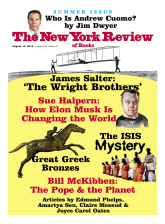In response to:
Gaudí’s Great Temple from the June 25, 2015 issue
To the Editors:
Martin Filler presents an excellent review of Antoni Gaudí the architect [“Gaudí’s Great Temple,” NYR, June 25] but near the end of his article he throws in fantasies of Park Güell dragons and sea serpents. Gaudí apparently was a better herpetologist than Filler. Gaudí’s circa ten-foot-high lizards on the side of the Basilica Sagrada Familia in Barcelona, Spain, are accurate, lifelike with no hint of dragonness. It would be a fun joke if they were wall lizards, Lacerta muralis, but they have more rounded heads and a distinct neck so they look to me (I crawled about the building and up and within the towers in 1967 and have photographs) like garden lizards, Calotes calotes.
The large multicolored lizard that greets visitors to Park Güell appears to be either a garden lizard or the North African rainbow lizard, Agama agama. Both lizards are common and colorful. It is a reptile as it has scales (colored tiles). It is not a crocodile as some have said (it has small scales and a round head, not a flat head). It is a lizard, but not a gecko (the toes are wrong). It is not a chameleon (the tail and toes are wrong). The head scales, body, and tail shape suggest that it is an agamid (Old World common lizard) and probably a garden or rainbow lizard the bright colors of which Gaudí has enhanced with his colored tiles.
There is no basis for calling Park Güell’s serpentine bench a sea serpent! There is little sea life seen in Gaudí art and there are no sea snakes in nearby sea and ocean waters.
Bayard H. Brattstrom
Emeritus Professor of Zoology
California State University
Fullerton, California
Martin Filler replies:
Professor Brattstrom’s illuminating letter makes me regret that I did not sign up for the Herpetology 101 course that so tempted me as an undergraduate. However, I doubt that Antoni Gaudí was much more formally versed in the scientific particulars of animal or plant biology than I was. It seems to me that what makes this architect’s extraordinary fantasies on the natural world so remarkable is his inventive imagination, rather than any strict fidelity to this or that prototype. After all, few paleontologists have objected to architectural historians’ likening the undulating roofline of Gaudí’s Casa Batlló to a dinosaur, whatever specific genus it might be thought to approximate.



